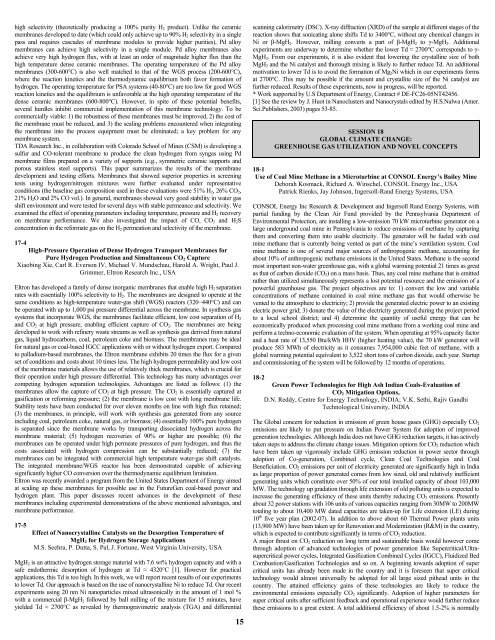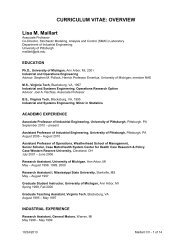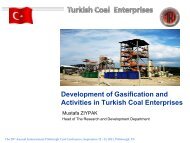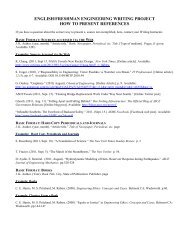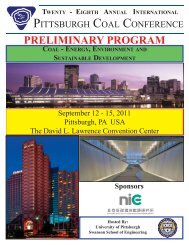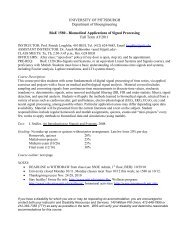Abstract Booklet 2006 - Swanson School of Engineering - University ...
Abstract Booklet 2006 - Swanson School of Engineering - University ...
Abstract Booklet 2006 - Swanson School of Engineering - University ...
Create successful ePaper yourself
Turn your PDF publications into a flip-book with our unique Google optimized e-Paper software.
high selectivity (theoretically producing a 100% purity H 2 product). Unlike the ceramic<br />
membranes developed to date (which could only achieve up to 90% H 2 selectivity in a single<br />
pass and requires cascades <strong>of</strong> membrane modules to provide higher purities), Pd alloy<br />
membranes can achieve high selectivity in a single module. Pd alloy membranes also<br />
achieve very high hydrogen flux, with at least an order <strong>of</strong> magnitude higher flux than the<br />
high temperature dense ceramic membranes. The operating temperature <strong>of</strong> the Pd alloy<br />
membranes (300-600°C) is also well matched to that <strong>of</strong> the WGS process (200-600°C),<br />
where the reaction kinetics and the thermodynamic equilibrium both favor formation <strong>of</strong><br />
hydrogen. The operating temperature for PSA systems (40-80°C) are too low for good WGS<br />
reaction kinetics and the equilibrium is unfavorable at the high operating temperature <strong>of</strong> the<br />
dense ceramic membranes (600-800°C). However, in spite <strong>of</strong> these potential benefits,<br />
several hurdles inhibit commercial implementation <strong>of</strong> this membrane technology. To be<br />
commercially viable: 1) the robustness <strong>of</strong> these membranes must be improved, 2) the cost <strong>of</strong><br />
the membrane must be reduced, and 3) the sealing problems encountered when integrating<br />
the membrane into the process equipment must be eliminated; a key problem for any<br />
membrane system.<br />
TDA Research Inc., in collaboration with Colorado <strong>School</strong> <strong>of</strong> Mines (CSM) is developing a<br />
sulfur and CO-tolerant membrane to produce the clean hydrogen from syngas using Pd<br />
membrane films prepared on a variety <strong>of</strong> supports (e.g., symmetric ceramic supports and<br />
porous stainless steel supports). This paper summarizes the results <strong>of</strong> the membrane<br />
development and testing efforts. Membranes that showed superior properties in screening<br />
tests using hydrogen/nitrogen mixtures were further evaluated under representative<br />
conditions (the baseline gas composition used in these evaluations were 51% H 2 , 26% CO 2 ,<br />
21% H 2 O and 2% CO vol.). In general, membranes showed very good stability in water gas<br />
shift environment and were tested for several days with stable permeance and selectivity. We<br />
examined the effect <strong>of</strong> operating parameters including temperature, pressure and H 2 recovery<br />
on membrane performance. We also investigated the impact <strong>of</strong> CO, CO 2 and H 2 S<br />
concentration in the reformate gas on the H 2 permeation and selectivity <strong>of</strong> the membrane.<br />
17-4<br />
High-Pressure Operation <strong>of</strong> Dense Hydrogen Transport Membranes for<br />
Pure Hydrogen Production and Simultaneous CO 2 Capture<br />
Xiaobing Xie, Carl R. Everson IV, Michael V. Mundschau, Harold A. Wright, Paul J.<br />
Grimmer, Eltron Research Inc., USA<br />
Eltron has developed a family <strong>of</strong> dense inorganic membranes that enable high H 2 separation<br />
rates with essentially 100% selectivity to H 2 . The membranes are designed to operate at the<br />
same conditions as high-temperature water-gas shift (WGS) reactors (320−440°C) and can<br />
be operated with up to 1,000 psi pressure differential across the membrane. In synthesis gas<br />
systems that incorporate WGS, the membranes facilitate efficient, low cost separation <strong>of</strong> H 2<br />
and CO 2 at high pressure, enabling efficient capture <strong>of</strong> CO 2 . The membranes are being<br />
developed to work with refinery waste streams as well as synthesis gas derived from natural<br />
gas, liquid hydrocarbons, coal, petroleum coke and biomass. The membranes may be ideal<br />
for natural gas or coal-based IGCC applications with or without hydrogen export. Compared<br />
to palladium-based membranes, the Eltron membrane exhibits 20 times the flux for a given<br />
set <strong>of</strong> conditions and costs about 10 times less. The high hydrogen permeability and low cost<br />
<strong>of</strong> the membrane materials allows the use <strong>of</strong> relatively thick membranes, which is crucial for<br />
their operation under high pressure differential. This technology has many advantages over<br />
competing hydrogen separation technologies. Advantages are listed as follows: (1) the<br />
membranes allow the capture <strong>of</strong> CO 2 at high pressure. The CO 2 is essentially captured at<br />
gasification or reforming pressure; (2) the membrane is low cost with long membrane life.<br />
Stability tests have been conducted for over eleven months on line with high flux retained;<br />
(3) the membranes, in principle, will work with synthesis gas generated from any source<br />
including coal, petroleum coke, natural gas, or biomass; (4) essentially 100% pure hydrogen<br />
is separated since the membrane works by transporting dissociated hydrogen across the<br />
membrane material; (5) hydrogen recoveries <strong>of</strong> 90% or higher are possible; (6) the<br />
membranes can be operated under high permeate pressures <strong>of</strong> pure hydrogen, and thus the<br />
costs associated with hydrogen compression can be substantially reduced; (7) the<br />
membranes can be integrated with commercial high temperature water-gas shift catalysts.<br />
The integrated membrane/WGS reactor has been demonstrated capable <strong>of</strong> achieving<br />
significantly higher CO conversion over the thermodynamic equilibrium limitation.<br />
Eltron was recently awarded a program from the United States Department <strong>of</strong> Energy aimed<br />
at scaling up these membranes for possible use in the FutureGen coal-based power and<br />
hydrogen plant. This paper discusses recent advances in the development <strong>of</strong> these<br />
membranes including experimental demonstrations <strong>of</strong> the above mentioned advantages, and<br />
membrane performance.<br />
17-5<br />
Effect <strong>of</strong> Nanocrystalline Catalysts on the Desorption Temperature <strong>of</strong><br />
MgH 2 for Hydrogen Storage Applications<br />
M.S. Seehra, P. Dutta, S. Pal, J. Fortune, West Virginia <strong>University</strong>, USA<br />
MgH 2 is an attractive hydrogen storage material with 7.6 wt% hydrogen capacity and with a<br />
safe endothermic desorption <strong>of</strong> hydrogen at Td ≈ 4320°C [1]. However for practical<br />
applications, this Td is too high. In this work, we will report recent results <strong>of</strong> our experiments<br />
to lower Td. Our approach is based on the use <strong>of</strong> nanocrystalline Ni to reduce Td. Our recent<br />
experiments using 20 nm Ni nanoparticles mixed ultrasonically in the amount <strong>of</strong> 1 mol %<br />
with a commercial β-MgH 2 followed by ball milling <strong>of</strong> the mixture for 15 minutes, have<br />
yielded Td ≈ 2700°C as revealed by thermogravimetric analysis (TGA) and differential<br />
15<br />
scanning calorimetry (DSC). X-ray diffraction (XRD) <strong>of</strong> the sample at different stages <strong>of</strong> the<br />
reaction shows that sonicating alone shifts Td to 3400°C, without any chemical changes in<br />
Ni or β-MgH 2 . However, milling converts a part <strong>of</strong> β-MgH 2 to γ-MgH 2 . Additional<br />
experiments are underway to determine whether the lower Td ≈ 2700°C corresponds to γ-<br />
MgH 2 . From our experiments, it is also evident that lowering the crystalline size <strong>of</strong> both<br />
MgH 2 and the Ni catalyst and thorough mixing is likely to further reduce Td. An additional<br />
motivation to lower Td is to avoid the formation <strong>of</strong> Mg 2 Ni which in our experiments forms<br />
at 2700°C. This may be possible if the amount and crystallite size <strong>of</strong> the Ni catalyst are<br />
further reduced. Results <strong>of</strong> these experiments, now in progress, will be reported.<br />
* Work supported by U.S Department <strong>of</strong> Energy, Contract # DE-FC26-05NT42456.<br />
[1] See the review by J. Huot in Nanoclusters and Nanocrystals edited by H.S.Nalwa (Amer.<br />
Sci.Publishers, 2003) pages 53-85.<br />
SESSION 18<br />
GLOBAL CLIMATE CHANGE:<br />
GREENHOUSE GAS UTILIZATION AND NOVEL CONCEPTS<br />
18-1<br />
Use <strong>of</strong> Coal Mine Methane in a Microturbine at CONSOL Energy’s Bailey Mine<br />
Deborah Kosmack, Richard A. Winschel, CONSOL Energy Inc., USA<br />
Patrick Rienks, Jay Johnson, Ingersoll-Rand Energy Systems, USA<br />
CONSOL Energy Inc Research & Development and Ingersoll Rand Energy Systems, with<br />
partial funding by the Clean Air Fund provided by the Pennsylvania Department <strong>of</strong><br />
Environmental Protection, are installing a low-emission 70 kW microturbine generator on a<br />
large underground coal mine in Pennsylvania to reduce emissions <strong>of</strong> methane by capturing<br />
them and converting them into usable electricity. The generator will be fueled with coal<br />
mine methane that is currently being vented as part <strong>of</strong> the mine’s ventilation system. Coal<br />
mine methane is one <strong>of</strong> several major sources <strong>of</strong> anthropogenic methane, accounting for<br />
about 10% <strong>of</strong> anthropogenic methane emissions in the United States. Methane is the second<br />
most important non-water greenhouse gas, with a global warming potential 21 times as great<br />
as that <strong>of</strong> carbon dioxide (CO 2 ) on a mass basis. Thus, any coal mine methane that is emitted<br />
rather than utilized simultaneously represents a lost potential resource and the emission <strong>of</strong> a<br />
powerful greenhouse gas. The project objectives are to: 1) convert the low and variable<br />
concentrations <strong>of</strong> methane contained in coal mine methane gas that would otherwise be<br />
vented to the atmosphere to electricity; 2) provide the generated electric power to an existing<br />
electric power grid; 3) donate the value <strong>of</strong> the electricity generated during the project period<br />
to a local school district; and 4) determine the quantity <strong>of</strong> useful energy that can be<br />
economically produced when processing coal mine methane from a working coal mine and<br />
perform a techno-economic evaluation <strong>of</strong> the system. When operating at 95% capacity factor<br />
and a heat rate <strong>of</strong> 13,550 Btu/kWh HHV (higher heating value), the 70 kW generator will<br />
produce 583 MWh <strong>of</strong> electricity as it consumes 7,954,000 cubic feet <strong>of</strong> methane, with a<br />
global warming potential equivalent to 3,522 short tons <strong>of</strong> carbon dioxide, each year. Startup<br />
and commissioning <strong>of</strong> the system will be followed by 12 months <strong>of</strong> operations.<br />
18-2<br />
Green Power Technologies for High Ash Indian Coals-Evaluation <strong>of</strong><br />
CO 2 Mitigation Options,<br />
D.N. Reddy, Centre for Energy Technology, INDIA; V.K. Sethi, Rajiv Gandhi<br />
Technological <strong>University</strong>, INDIA<br />
The Global concern for reduction in emission <strong>of</strong> green house gases (GHG) especially CO 2<br />
emissions are likely to put pressure on Indian Power System for adoption <strong>of</strong> improved<br />
generation technologies. Although India does not have GHG reduction targets, it has actively<br />
taken steps to address the climate change issues. Mitigation options for CO 2 reduction which<br />
have been taken up vigorously include GHG emission reduction in power sector through<br />
adoption <strong>of</strong> Co-generation, Combined cycle, Clean Coal Technologies and Coal<br />
Beneficiation. CO 2 emissions per unit <strong>of</strong> electricity generated are significantly high in India<br />
as large proportion <strong>of</strong> power generated comes from low sized, old and relatively inefficient<br />
generating units which constitute over 50% <strong>of</strong> our total installed capacity <strong>of</strong> about 103,000<br />
MW. The technology up gradation through life extension <strong>of</strong> old polluting units is expected to<br />
increase the generating efficiency <strong>of</strong> these units thereby reducing CO 2 emissions. Presently<br />
about 32 power stations with 106 units <strong>of</strong> various capacities ranging from 30MW to 200MW<br />
totaling to about 10,400 MW dated capacities are taken-up for Life extension (LE) during<br />
10 th five year plan (2002-07). In addition to above about 60 Thermal Power plants units<br />
(13,900 MW) have been taken up for Renovation and Modernization (R&M) in the country,<br />
which is expected to contribute significantly in terms <strong>of</strong> CO 2 reduction.<br />
A major thrust on CO 2 reduction on long term and sustainable basis would however come<br />
through adoption <strong>of</strong> advanced technologies <strong>of</strong> power generation like Supercritical/Ultrasupercritical<br />
power cycles, Integrated Gasification Combined Cycles (IGCC), Fluidized Bed<br />
Combustion/Gasification Technologies and so on. A beginning towards adoption <strong>of</strong> super<br />
critical units has already been made in the country and it is foreseen that super critical<br />
technology would almost universally be adopted for all large sized pithead units in the<br />
country. The attained efficiency gains <strong>of</strong> these technologies are likely to reduce the<br />
environmental emissions especially CO 2 significantly. Adoption <strong>of</strong> higher parameters for<br />
super critical units after sufficient feedback and operational experience would further reduce<br />
these emissions to a great extent. A total additional efficiency <strong>of</strong> about 1.5-2% is normally


